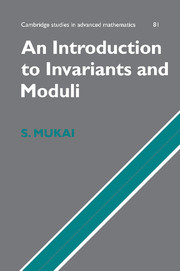Book contents
- Frontmatter
- Contents
- Preface
- Acknowledgements
- Introduction
- 1 Invariants and moduli
- 2 Rings and polynomials
- 3 Algebraic varieties
- 4 Algebraic groups and rings of invariants
- 5 The construction of quotient varieties
- 6 The projective quotient
- 7 The numerical criterion and some applications
- 8 Grassmannians and vector bundles
- 9 Curves and their Jacobians
- 10 Stable vector bundles on curves
- 11 Moduli functors
- 12 Intersection numbers and the Verlinde formula
- Bibliography
- Index
- References
5 - The construction of quotient varieties
Published online by Cambridge University Press: 05 February 2015
- Frontmatter
- Contents
- Preface
- Acknowledgements
- Introduction
- 1 Invariants and moduli
- 2 Rings and polynomials
- 3 Algebraic varieties
- 4 Algebraic groups and rings of invariants
- 5 The construction of quotient varieties
- 6 The projective quotient
- 7 The numerical criterion and some applications
- 8 Grassmannians and vector bundles
- 9 Curves and their Jacobians
- 10 Stable vector bundles on curves
- 11 Moduli functors
- 12 Intersection numbers and the Verlinde formula
- Bibliography
- Index
- References
Summary
Suppose that an algebraic group G acts on an affine variety X = Spm R (where we assume throughtout that R is an integral domain over k). We will consider the map to affine space
ø : X → Anx ↦ (f1(x), …, fn(x)),
given by some G-invariant functions f1, …, fn ∈ RG. Since each fi is G-invariant, it is constant on the G-orbits. It follows that the map φ sends each orbit to a single point. This suggests – although a slight oversimplification – the essential idea for constructing a quotient variety by means of the invariant functions:
Aim: By taking sufficiently many invariants f1, …, fn ∈ RG, can we obtain a ‘quotient variety’ X/G as the image φ(X) ⊂ An?
First of all, what do we mean by ‘sufficiently many’ here? If the group G is linearly reductive, then by Hilbert's Theorem 4.51 the invariant ring RG is finitely generated. In this case it should be enough to take f1, …, fn to be a set of generators. Second, our use of the word ‘quotient’ begs the following question:
Question 1: Do two distinct G-orbits always map to distinct points under φ?
Given that the functions f1, …, fn used to define φ generate all the invariants, this can be rephrased: given two distinct orbits of the G-action, does there exist any invariant form taking different values on the two orbits?
Moreover, if we ask for a ‘variety’ as the quotient, then we cannot avoid the following question. We have seen in Example 3.22 that the image of a morphism of algebraic varieties need not itself be an algebraic variety.
Question 2: Is the image of φ in An an algebraic variety?
We shall examine these questions in this chapter, and to what extent it is valid and consistent to view the image of φ(X) ⊂ An (or more fundamentally Spm RG) as the quotient of X by G.
- Type
- Chapter
- Information
- An Introduction to Invariants and Moduli , pp. 158 - 180Publisher: Cambridge University PressPrint publication year: 2003

